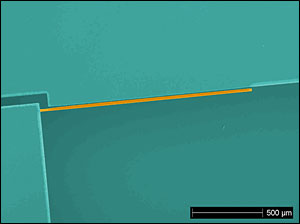
Radio Waves Cool Cantilever
BOULDER, Colo., Sept. 17, 2007 -- Physicists have used radio waves to dampen the motion of a thin silicon cantilever containing more than a quadrillion atoms, a cooling technique that has the potential to demonstrate quantum behavior in a macroscopic object using smaller and simpler equipment and could lead to the creation of very sensitive detectors.
NIST physicists used radio waves to cool this silicon microcantilever, the narrow orange strip across the middle of this colorized micrograph. The cantilever, created by ion etching through a silicon wafer, lies parallel to a silicon radio-frequency electrode. (Image: J. Britton/NIST)
Visible and ultraviolet laser light has been used for years to cool trapped atoms -- and more recently larger objects -- by reducing the extent of their thermal motion. Now, physicists at the National Institute of Standards and Technology (NIST) lab in Boulder are the first to cool a micron-sized cantilever using standard radio-frequency technology instead of with precision optical elements or lasers, making it easier to put the setup on a chip and immerse that chip in a cryogenic environment.
This demonstration of radio-frequency (RF) cooling of a relatively large object may offer a new tool for exploring the bizarre quantum behavior seen in the smallest particles of matter and light. There may be technology applications as well: the RF circuit could be made small enough to be incorporated on a chip with tiny oscillators, a focus of intensive research for use in sensors to detect, for example, molecular forces.
The NIST experiments used an RF circuit to cool a 200 x 14 x 1500-µm silicon cantilever -- a tiny “diving board” affixed at one end to a chip and similar to the tuning forks used in quartz crystal watches -- vibrating at 7000 cycles per second, its natural “resonant” frequency. Scientists cooled it from room temperature (about 73 °F) to -228 °C (-379 °F).
Other research groups have used optical techniques to chill microcantilevers to lower temperatures, but the RF technique may be more practical in some cases, because the equipment is smaller and easier to fabricate and integrate into cryogenic systems. By extending the RF method to higher frequencies at cryogenic temperatures, scientists hope eventually to cool a cantilever to its “ground state” near absolute zero (-273 °C or -460 °F), where it would be essentially motionless and quantum behavior should emerge.
Laser cooling is akin to using the kinetic energy of millions of Ping-Pong balls (particles of light) striking a rolling bowling ball (such as an atom) to slow it down. The RF cooling technique, NIST's Kenton Brown said, is more like pushing a child on a swing slightly out of synch with its back-and-forth motion to reduce its arc.
In the NIST experiments, the cantilever’s mechanical motion is reduced by the force created between two electrically charged plates, one of which is the cantilever, which store energy like electrical capacitors. In the absence of any movement, the force would be stable, but in this case, it is modulated by the cantilever vibrations. The stored energy takes some time to change in response to the cantilever’s movement, and this delay pushes the cantilever slightly out of synch, damping its motion.
Brown is lead author on a paper describing the work, which will appear in an upcoming issue of Physical Review Letters.
For more information, visit: www.nist.gov
Published: September 2007